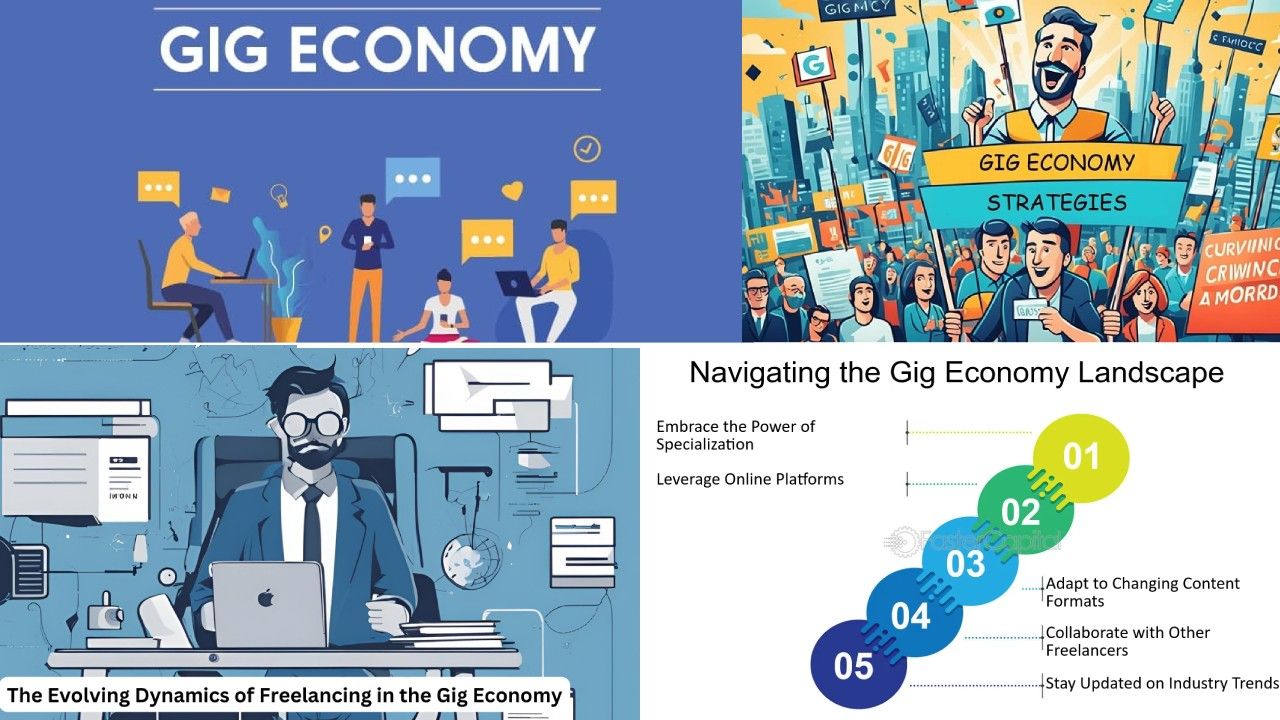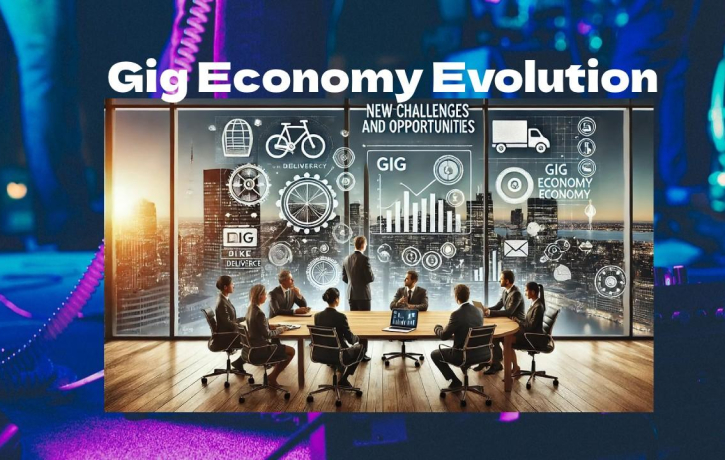
The gig economy has evolved from being a niche side hustle to become a dominant force in the global workforce. Technological advancements, a shift in work paradigms, and changing attitudes towards employment have made freelancing and gig work central to how people earn a living. Navigating today’s fast-changing economic landscape of freelance opportunities requires a strategic approach to succeed. This article explains the development of the gig economy and how to succeed in it.
What is the Gig Economy?
The gig economy is the type of labor market that has short-term, flexible jobs—often facilitated by digital platforms—where individuals can work as independent contractors or freelancers rather than full-time employees. Gig work is generally project-based, temporary, and often involves flexibility in both hours and location.
While the gig economy is characterized by part-time or low-wage work, it has actually expanded incredibly and attracted highly skilled professionals: tech, design, marketing, education, and consulting among others.
Evolution of Gig Economy
1. Digital Platforms Ascendancy 2000s-2010
The early 2000s marked the start of significant shifts toward gig work, particularly with the rise of digital platforms like Uber, TaskRabbit, and Fiverr. It would allow people to directly contact clients, hence avoiding conventional employment structures. The work that was traditionally associated with transportation or house cleaning can now be extended into many types of skills.
For instance, upwork.com and freelancer.com provided a marketplace for professionals interested in freelancing in tech, writing, marketing, and more. Therefore, such democratization of freelancing enabled people to engage in freelance work remotely to clients spread across the entire globe.
2. Globalization and Technological Advancement (2010s-to-date)
As internet speeds improved and cloud-based tools grew in popularity, working remotely became an option for millions. Freelancing in software development, design, digital marketing, and content creation, among other areas, was not only accessible but also well-paid. Collaboration and project management through Slack, Zoom, and Trello made working on a gig economy a mainstay of the modern workforce.
In the 2010s, Toptal and Guru have focused on high-skilled professionals by providing them with high-end freelance work opportunities. Many people were shifting from the traditional 9-to-5 job sector to freelancing, wanting independence, work-life balance, and working with clients around the world.
3. Pandemic Era Boom (2020-Present)
The COVID-19 pandemic was an accelerant to the growth of the gig economy, as companies and employees alike moved toward remote work. This gave many professionals the chance to shift out of full-time employment and into freelancing, as companies increasingly relied on gig workers to meet their needs without the overhead of full-time employees.
The work-from-home revolution is here to stay. Loads of businesses are more likely than ever before to engage contract and freelance folks on flexible instead of traditional full-time hiring. As a result, markets such as AngelList for professional startuppers, 99designs for creative talents have mushroomed.
Freelance Opportunities Today
The fast-growing gig economy requires freelancers to become very strategic in order to remain in this arena. Here are a few main strategies to thrive in this modern gig economy:
1. Build a Personal Brand
In the gig economy, branding is extremely critical when it comes to differentiation. A strong personal brand enables easier access to potential clients, who can trust the kind of expertise you hold. A personal brand may involve the following:
A professional website or portfolio: Showcase past work, client testimonials, and a clear value proposition.
Having a presence on social media: LinkedIn, Twitter, Instagram are great tools to connect with potential clients and showcase expertise.
Thought leadership: The attainment of credibility through writing blogs, video content, or public speaking.
A well-defined personal brand is essential to attracting the right kind of clients and also be able to have a better rate.
2. Leverage Freelance Platforms
Freelance platforms are the lifeblood of the gig economy. These digital marketplaces connect freelancers with clients, often providing job listings, payment protection, and project management tools. Some of the most popular platforms include:
Upwork: Ideal for a broad range of skills, from writing and design to programming and marketing.
Fiverr: Best suited for small projects, offering gigs starting at $5, though many freelancers scale their offerings.
Toptal: Exclusive to high-end talent in tech and finance with high-paying opportunities.
Freelancer: Diverse freelance opportunity options across various industries
When using platforms, apply your strategy on how to effectively use them. Update your profile, keep your rates competitive, and apply to projects that best suit your skill sets.
3. Learn to Master Time Management and Set Boundaries
Freelancing can be flexible, but it demands very good time management. A freelancer will have many projects at the same time, and it is so tempting to overwork or accept every opportunity that comes in your way.
To avoid burnout and stay productive:
Set clear work hours: Even being a freelancer, having a routine helps you stay focused and on track.
Use productivity tools: Tools like Trello, Asana, and Time Doctor can help you track tasks, manage deadlines, and monitor time.
Establish boundaries with clients: Be clear about availability and establish expectations for response times so clients respect the work-life balance.
4. Diversify Your Income Streams
In the gig economy, you are most likely to be vulnerable to having one client or one type of project. This is one of the ways you could diversify your income and create more financial stability. Here are some ways:
Offer multiple services: If you are a designer, maybe you also offer branding consultancy, website design, or even digital marketing services.
Passive income: Create digital products, which include eBooks, online courses, or stock photos, that are going to generate revenue over time.
Several freelance sites: Having several accounts will boost your chances to win the jobs and introduce you to new customers.
5. Up-skilling and Specialisation
Gig economy has been founded upon talent and in order to compete it is always upgrading one’s up-skilling skills according to the current needs in the marketplace. A specific niche would be highly demanded with lower competition can be considered like:
Tech: Cloud computing, AI, ML, Cyber security is hot area in the marketplace. High Paying freelance Jobs.
Creative: Specializing in a specific design style or creative niche, such as UX/UI design or branding, can help you attract high-paying clients.
Marketing: Focus on emerging trends like SEO, content marketing, or social media strategy to stay ahead of the curve.
By positioning yourself as an expert in a particular field, you can attract higher-paying clients and increase your long-term earning potential.
6. Understand Tax and Legal Implications
Freelancers need to take care of taxes for themselves. They, therefore, need to know about the tax laws and proper financial planning. One should keep an account of all their income as well as expenses and seek the help of an accountant or freelance tax preparer.
Legal considerations include:
Agreements: Enter into an agreement with a client specifying the scope of work, deadlines, and terms of payment.
Invoicing: Ensure that your invoices are professional and will include your business name, the terms of payment, and taxes.
Business Structure: You may choose to go as a sole proprietorship, LLC, or any other structure that suits your needs in terms of tax and the law.
7. Networking and Relationship Building
Network building is one of the most essential aspects of growing your freelance career. A good network can lead to referrals and repeat clients and new chances. Here’s how you can network effectively:
Attend industry events: Virtual conferences, webinars, and networking events are great places to connect with potential clients.
Join online communities: Participate in forums and groups related to your niche on platforms like Reddit, Facebook, and Slack.
Client relationships: Foster strong relationships with clients by delivering high-quality work on time and maintaining open communication.
Conclusion
The gig economy has developed into a complex scenario, full of opportunities for those who are willing to adapt to its flexibility and challenges. Building a robust personal brand, mastering time management, diversifying income streams, and continually honing your skills will help you thrive in today’s economy as a freelancer. With the right mindset and strategic approach, the gig economy offers endless potential for career growth, financial independence, and personal freedom.






